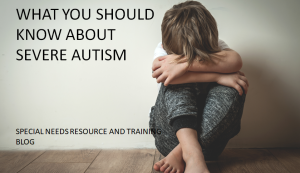What you should know about severe autism
Media is slowly getting better in it’s portrayal of people with autism in both movies and television, while many still hold onto to the perception of “Rain Man”, I do believe we are moving in the right direction. Still, little is discussed or talked about when it comes to children and adults with severe autism. Some may refer to severe autism as “low functioning when in fact autism is a spectrum in both symptoms and behaviors and varies from person to person.
Children and adults with severe autism often display the following signs :
- Impaired social interaction
- Difficulty in communicating- both expressive and receptive
- Obsessive compulsive disorder
- anxiety
- aggressiveness
- self-injurious
According to the 5th edition of the Diagnostic and Statistical Manual of Mental Disorders (DSM-5), there are 3 levels of severity based on social communication impairments, restricted, and patterns of behaviors. The severity level (Level 3) is defined as requiring very substantial support. For example the person may exhibit very limited initiation of social interaction and extreme difficulty with coping and change. signs may include an indifference in others, using negative behavior to communicate, very little or echolalia, sensory sensitivity will vary from severe to none, may be self-injurious and have an intellectual disability. Below you will find articles on understanding severe nonverbal autism:
5 nonverbal children that found their voices
Autism: How do you communicate with a non-verbal child
Helping nonverbal kids to communicate
I have nonverbal autism…Here is what I want you to know
Nonverbal autism: Symptoms and treatment activities
Missing brain wave may explain language problems in nonverbal autism
What can we learn from studying severe autism?
What makes severe autism so challenging?
Why being nonverbal doesn’t mean being non-capable
Why children with severe autism are overlooked?
Updated 8/23/2020


